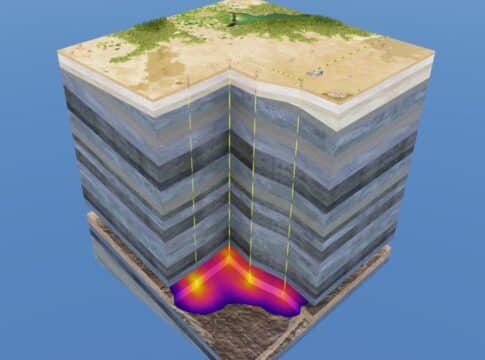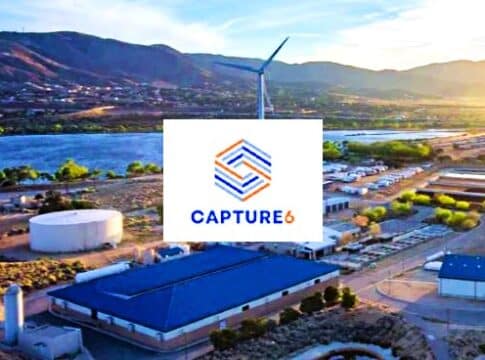Nvidia AI Tech Ramps Up Carbon Capture & Storage Predictions 700,000x
Nvidia Corporation, a giant tech company that’s a leading supplier of artificial intelligence (AI) hardware and software, unveiled its new approach to carbon capture and storage (CCS) that scientists and engineers can use to accelerate carbon sequestration.
Carbon capture and storage, also called carbon sequestration, is one way to mitigate climate change by redirecting carbon deep underground. During the process, CCS scientists must prevent fracturing geological formations where carbon is injected, leaking CO2 into aquifers, or worse back into the atmosphere.
That can happen if there’s too much pressure buildup due to the process of injecting carbon into the rock formations. This, and more, is what Nvidia’s Ai-powered technology addresses to help improve carbon sequestration.
Nvidia AI: Ramping Up Carbon Capture Modeling 700,000x
CCS is one of few methods that industries like oil and gas, cement, and steel can deploy to decarbonize and meet their net zero targets. More than a hundred CCS facilities are under construction worldwide.
Traditional simulators for carbon sequestration are costly to own and require a lot of time to complete. Machine learning and AI models deliver the same level of accuracy but at reduced cost and time.
Nvidia introduces its AI approach to carbon sequestration that CCS scientists can readily use in real-world applications through Nvidia Modulus and Nvidia Omniverse.
Nvidia’s AI-powered technology accelerates CCS modeling 700,000x using Fourier Neural Operators (FNO) architecture.
Nvidia’s Approach to CCS Modeling
Source: Nvidia website
FNO architecture provides more accurate predictions of pressure buildup and CO2 saturation. It’s 2x as accurate while needing only a third of the training data compared to other computer models.
As such, the software helps CCS engineers to choose the best injection sites fast, identify the optimal spacing and depth of wells, as well as determine the best injection pressure and rate for the captured carbon. Moreover, engineers can visualize and optimize the entire inspection process through Nvidia Omniverse.
With its superior computing abilities, Nvidia software increases the carbon sequestration simulation speed 700,000 times. A robust assessment for CO2 plume and pressure buildup usually takes about 2 years using numerical simulators. But with Nvidia’s FNO, it may take 2.8 seconds only.
Trained Nvidia FNO models are available in a web application to provide real-time simulations for carbon capture and storage projects.
Thus, AI technology enables various tasks vital in making CCS decisions.
Improving Carbon Sequestration
Scientists use carbon storage simulations or modeling to pick the right CO2 injection sites and rates. Modeling also helps them optimize storage efficiency, control pressure buildup, and make sure that rock formations don’t get fractured.
CCS engineers must also understand how the injected CO2 will spread through the ground, also called a CO2 plume.
Nvidia technology was found useful by a study to achieve an AI-powered carbon capture and storage with interactivity at scale. Using it, engineers can interact with the models to guarantee the reliability and safety of a CCS project. A safe and accurate CO2 storage process can help reduce the amount of carbon escaping into the air.
Here’s a video by Nvidia explaining the CCS process and how its AI technology can help accelerate things.
FNO allows scientists to simulate how pressure levels build up and where CO2 spreads throughout the 30 years of injection. Acceleration using this AI-powered model speeds up the simulation process from ten minutes to just seconds.
Without this technology, selecting injection sites for CO2 would seem like a shot in the dark.
AI for Net Zero
Achieving net zero emissions by 2050 requires a combination of different scalable technologies such as CCS.
As per the International Energy Agency (IEA) report, the global planned carbon storage capacity rose by 80% in 2022. For the same year, there’s also a 30% increase in planned carbon capture capacity.
Recent innovations in AI, with models like Nvidia’s FNO, can help ramp up CCS modeling by orders of magnitude. This is crucial in helping CCS technologies scale up.
There are also other AI innovations used in the industry.
For instance, Ohio-based analytics company Aperture launched its Carbon Capture Space last year. It is an AI-powered platform that offers industry analysts and investors insights into 1,000+ technologies for CCS.
Nvidia’s Earth-2, which will be the world’s first AI digital twin supercomputer, will leverage the FNO models. This tech will further show how AI can help speed up the process of mitigating climate change.
The tech company now tops Tesla as AI revolution pushes its shares to record high, up 200%. ESG investors prefer it to other traditional assets, with over 1,400 ESG funds directly holding Nvidia, according to Bloomberg report.
Nvidia and its AI models will help tackle the climate crisis by contributing to global climate change mitigation efforts. Leveraging the AI revolution would be one way for the world to be on its track to net zero.
The post Nvidia AI Tech Ramps Up Carbon Capture & Storage Predictions 700,000x appeared first on Carbon Credits.



